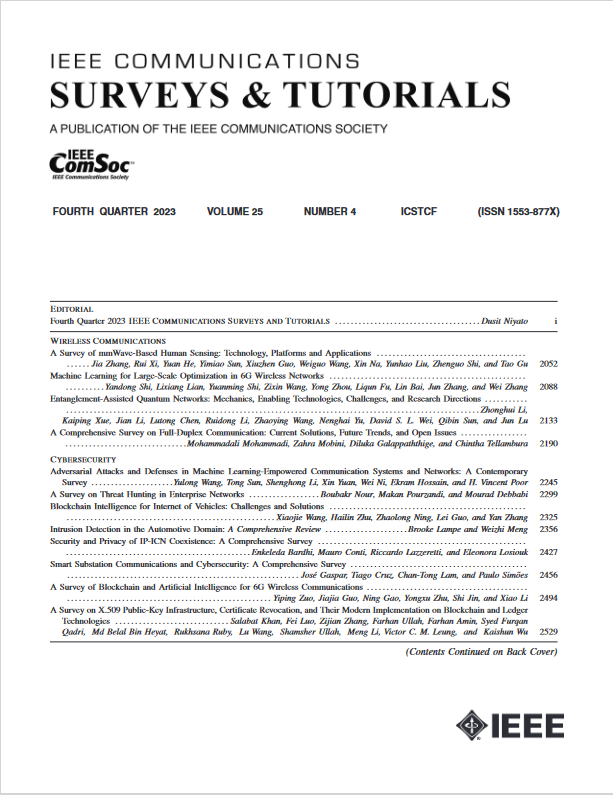迈向安全的智能电网 2.0:探索安全威胁、保护模式和挑战
IF 34.4
1区 计算机科学
Q1 COMPUTER SCIENCE, INFORMATION SYSTEMS
引用次数: 0
摘要
许多国家正在推动能源领域的绿色转型,以期到2050年实现碳排放中性。智能电网2.0 (SG2)有望探索数据驱动分析和增强通信技术,以提高分布式可再生能源系统的效率和可持续性。这些功能超出了传统智能电网的智能计量和剩余电力分配。由于SG2高度依赖通信网络连接分布式微电网,潜在的连接级联故障可能导致远程控制系统的数据同步中断。本文回顾了三个利益相关者的安全威胁和防御策略:电网运营商、通信网络提供商和消费者。通过调查,我们发现SG2的利益相关者特别容易受到变电站攻击/破坏、恶意软件/勒索软件威胁、区块链漏洞和供应链故障的影响。此外,将人工智能(AI)纳入SG2分布式能源的自主能源管理也带来了新的挑战。因此,发电厂的电力读取和测量传感器上的对抗性样本和虚假数据注入可能会欺骗人工智能控制功能,导致储能系统的错误检查操作混乱,电动汽车充电的错误能量估计,甚至点对点能源交易模型中的欺诈交易。可扩展的基于区块链的模型、物理不可克隆的功能、可互操作的安全协议和可信赖的人工智能模型设计用于管理SG2中的分布式微电网,是未来研究中典型的有前途的保护模型。本文章由计算机程序翻译,如有差异,请以英文原文为准。
Toward Secured Smart Grid 2.0: Exploring Security Threats, Protection Models, and Challenges
Many nations are promoting the green transition in the energy sector to attain neutral carbon emissions by 2050. Smart Grid 2.0 (SG2) is expected to explore data-driven analytics and enhance communication technologies to improve the efficiency and sustainability of distributed renewable energy systems. These features are beyond smart metering and electric surplus distribution in conventional smart grids. Given the high dependence on communication networks to connect distributed microgrids in SG2, potential cascading failures of connectivity can cause disruption to data synchronization to the remote control systems. This paper reviews security threats and defense tactics for three stakeholders: power grid operators, communication network providers, and consumers. Through the survey, we found that SG2‘s stakeholders are particularly vulnerable to substation attacks/vandalism, malware/ransomware threats, blockchain vulnerabilities and supply chain breakdowns. Furthermore, incorporating artificial intelligence (AI) into autonomous energy management in distributed energy resources of SG2 creates new challenges. Accordingly, adversarial samples and false data injection on electricity reading and measurement sensors at power plants can fool AI-powered control functions and cause messy error-checking operations in energy storage, wrong energy estimation in electric vehicle charging, and even fraudulent transactions in peer-to-peer energy trading models. Scalable blockchain-based models, physical unclonable function, interoperable security protocols, and trustworthy AI models designed for managing distributed microgrids in SG2 are typical promising protection models for future research.
求助全文
通过发布文献求助,成功后即可免费获取论文全文。
去求助
来源期刊

IEEE Communications Surveys and Tutorials
COMPUTER SCIENCE, INFORMATION SYSTEMS-TELECOMMUNICATIONS
CiteScore
80.20
自引率
2.50%
发文量
84
审稿时长
6 months
期刊介绍:
IEEE Communications Surveys & Tutorials is an online journal published by the IEEE Communications Society for tutorials and surveys covering all aspects of the communications field. Telecommunications technology is progressing at a rapid pace, and the IEEE Communications Society is committed to providing researchers and other professionals the information and tools to stay abreast. IEEE Communications Surveys and Tutorials focuses on integrating and adding understanding to the existing literature on communications, putting results in context. Whether searching for in-depth information about a familiar area or an introduction into a new area, IEEE Communications Surveys & Tutorials aims to be the premier source of peer-reviewed, comprehensive tutorials and surveys, and pointers to further sources. IEEE Communications Surveys & Tutorials publishes only articles exclusively written for IEEE Communications Surveys & Tutorials and go through a rigorous review process before their publication in the quarterly issues.
A tutorial article in the IEEE Communications Surveys & Tutorials should be designed to help the reader to become familiar with and learn something specific about a chosen topic. In contrast, the term survey, as applied here, is defined to mean a survey of the literature. A survey article in IEEE Communications Surveys & Tutorials should provide a comprehensive review of developments in a selected area, covering its development from its inception to its current state and beyond, and illustrating its development through liberal citations from the literature. Both tutorials and surveys should be tutorial in nature and should be written in a style comprehensible to readers outside the specialty of the article.
 求助内容:
求助内容: 应助结果提醒方式:
应助结果提醒方式:


